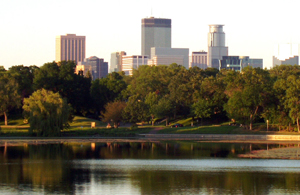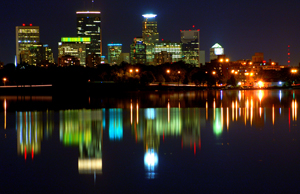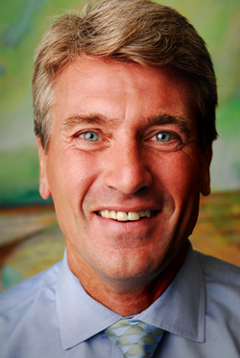Greening Minneapolis
Air Date: Week of April 18, 2008

Minneapolis has been ranked the 11th greenest city in the United States. (Photo: Dan Oldre)
Minneapolis Mayor R.T. Rybak tells host Steve Curwood about the unique environmental projects that have made Minneapolis one of the greenest cities in the country.
Transcript
CURWOOD: From a sustainable city in Brazil, we take you now to the City of Lakes… Minneapolis, Minnesota. Earlier this month Minneapolis released its 2008 GreenPrint Report, updating progress that city has made towards its sustainability goals. R.T. Rybak is the mayor of Minneapolis and he joins me now on the line to talk about the greening of his city. Mayor Rybak, welcome to Living on Earth!

Downtown Minneapolis at night reflected in Lake Calhoun.(Photo: Dan Oldre)
CURWOOD: Now, Popular Science magazine recently rated Minneapolis the eleventh greenest city in the country – and I suppose you –
RYBAK: We demand a recount.
CURWOOD: You demand a recount? Well, St. Paul was twelve.
RYBAK: (laughs) Well, that’s a wonderful thing. I think Minneapolis is doing some wonderful things. So are a lot of other people around the country too.
CURWOOD: Well, congratulations – but, of course, what are you going to do to be number one?
RYBAK: Well, I think one of the most important things is really engaging our citizens to be involved in those both big and little things that will make the city sustainable. So, uh, we’ve challenged everyone to be part of the, what’s called the Minnesota Energy Challenge. They look at their own lifestyle – the city does as well – and we collectively try to reduce, uh, as much of our CO2 as possible, and, uh, so far we’ve had about 3100 citizens sign up to save 21 million pounds.
CURWOOD: Tell me about, uh, your specific grant program to help Minneapolis deal with climate change.
RYBAK: We put out micro-grants, uh, $1000 to $10,000, and had a series of actions – some as small as a community organizing group working with Somali women, teaching them to ride bicycles so they can commute that way. Another neighborhood organization distributing clothes lines to replace dryers. A lot of community organizing along the idea of what you can do in your own neighborhood.
CURWOOD: What can a city like Minneapolis do in the face of gasoline headed to $4 and $5 a gallon or more, and of course it does generate carbon dioxide when it comes back out the tailpipe. In particular, what are you doing to get people out of their cars?

R.T. Rybak has been the mayor of Minneapolis since 2001. (Courtesy of Mayor R.T Rybak’s office)
Minneapolis’ climate is not perfect in the winter –
CURWOOD: Yeah. (laughs)
RYBAK: But it is the second best bike commuting city in the country. And that’s what’s so incredible about the people here, is it’s not an impediment.
CURWOOD: The Mississippi River runs right through the middle of parts of Minneapolis. It’s not particularly clean there. What are you doing to improve water quality?
RYBAK: One of the things that happens when you get a new job like mayor is that they give you a bunch of dirty little secrets you didn’t know about when you first, uh, wanted the job.
CURWOOD: (laughs)
RYBAK: In my second week in office, they came in and told me about what was called combined sewer overflow – that when there were extreme rains, that our system would overflow and raw sewage would go into the Mississippi. Well, that was obviously not something that we could tolerate. So we launched a very aggressive program to prevent those overflows, and it involved working with building owners to have them disconnect from the sewer system. It dealt with giving credits to homeowners for permeable surfaces so the water would seep in. Rain gardens, roof top gardens. And I’m really proud to say that as of last summer, we had no incidents of that – which was very good.

Minneapolis was ranked the 11th greenest city in the United States.(Photo: Dan Oldre)
CURWOOD: In the short term, though, how do you pay for all this?
RYBAK: Well, you have to make choices, and there is a, green premium that people pay, and I think that’s wrong – but I think we also have to take those aggressive steps, even if it means a little more in the short term. And I think we need to get ourselves back in harmony with the planet. That doesn’t mean having your head in the sky. But it does mean really laying out to citizens what’s at stake here.
I talk a lot about the natural beauty of the extraordinary place we call Minnesota. And Minnesota sits, um, in a pre-settlement, where the big woods met the prairie. If we think about that, and think about the poetry of a prairie and a big woods, think about a place where water flows in three directions – people begin to reconnect with the, uh, the land that they’re part of. You do not destroy something you love. And I think we have so taken our land for granted, that the more we connect people back to the magic of the places we live in – the more they will respect them and take the tough actions that we all need to take to be, uh, living in better harmony.
CURWOOD: R.T. Rybak is mayor of Minneapolis, Minnesota. Thank you so much, Mr. Mayor.
RYBAK: Thank you. It’s fun to talk about this.
Links
Living on Earth wants to hear from you!
Living on Earth
62 Calef Highway, Suite 212
Lee, NH 03861
Telephone: 617-287-4121
E-mail: comments@loe.org
Newsletter [Click here]
Donate to Living on Earth!
Living on Earth is an independent media program and relies entirely on contributions from listeners and institutions supporting public service. Please donate now to preserve an independent environmental voice.
NewsletterLiving on Earth offers a weekly delivery of the show's rundown to your mailbox. Sign up for our newsletter today!
 Sailors For The Sea: Be the change you want to sea.
Sailors For The Sea: Be the change you want to sea.
 The Grantham Foundation for the Protection of the Environment: Committed to protecting and improving the health of the global environment.
The Grantham Foundation for the Protection of the Environment: Committed to protecting and improving the health of the global environment.
 Contribute to Living on Earth and receive, as our gift to you, an archival print of one of Mark Seth Lender's extraordinary wildlife photographs. Follow the link to see Mark's current collection of photographs.
Contribute to Living on Earth and receive, as our gift to you, an archival print of one of Mark Seth Lender's extraordinary wildlife photographs. Follow the link to see Mark's current collection of photographs.
 Buy a signed copy of Mark Seth Lender's book Smeagull the Seagull & support Living on Earth
Buy a signed copy of Mark Seth Lender's book Smeagull the Seagull & support Living on Earth

